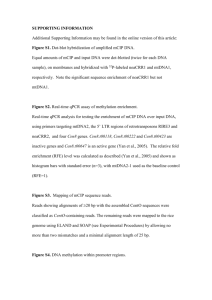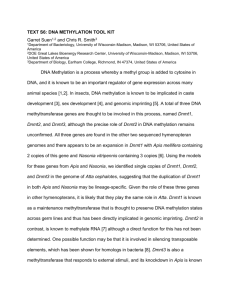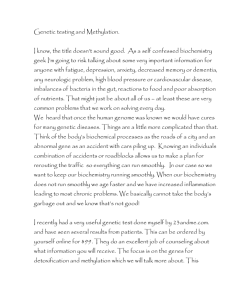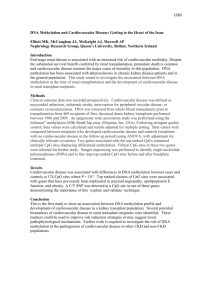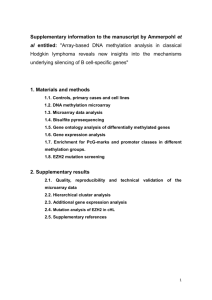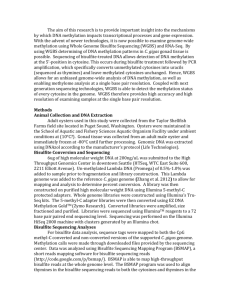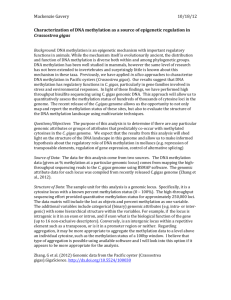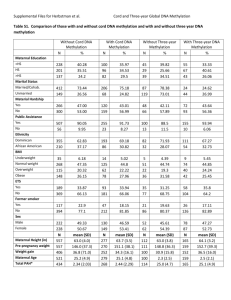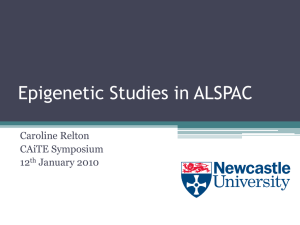DNA methyltransferases and DNA methylation in the pea aphid.
advertisement
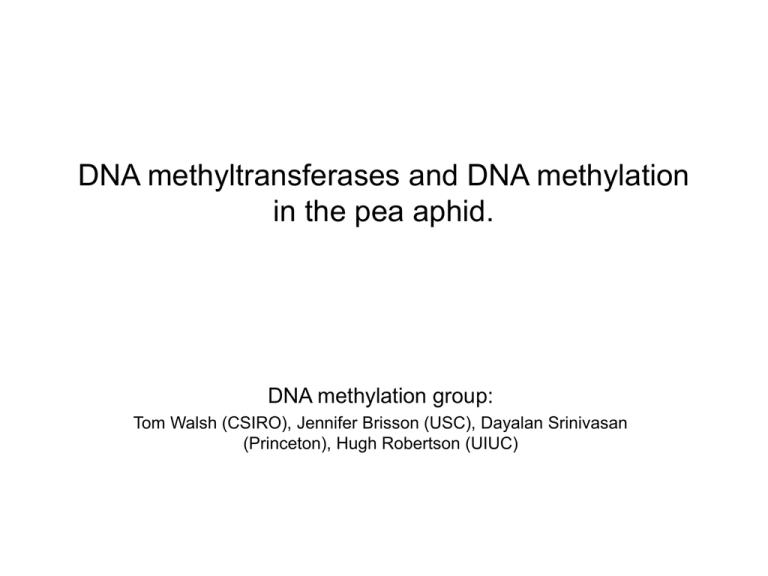
DNA methyltransferases and DNA methylation in the pea aphid. DNA methylation group: Tom Walsh (CSIRO), Jennifer Brisson (USC), Dayalan Srinivasan (Princeton), Hugh Robertson (UIUC) DNA methylation • Cytosine is methylated at CpG sites which acts as a marker for gene suppression (in vertebrates) • The DNA methylation status of genes can be changed by environmental factors • Aphids and organophosphate resistance (Green peach aphid, Myzus persicae) • Honey bee, Apis mellifera – Changes in methylation are associated with nutrition and the development of queens and workers • Other insects – Social Hymenoptera – Lepidoptera • Different to vertebrate methylation – Methylation is in the exons – Does not suppress gene expression The companion paper 1. 2. 3. 4. 5. 6. Annotation and phylogeny of the Dnmts Global amount of DNA methylation Which genes/regions are methylated in aphids? Expression of Dnmts Changes in methylation associated with morphs, environmental signals, nutrition etc. Expression of methylated genes 1. Annotation and phylogeny of the Dnmts • • • Dnmt1 – maintenance methyltransferase Dnmt2 – ? methyltransferase Dnmt3 – de-novo methyltransferase • • DMAP1 – DNA methyltransferase 1 associated protein 1 MBP – methyl binding domain proteins Diptera Brachycera Drosophila melanogaster Anopheles gambiae Nematocera Lepidoptera Bombyx mori Coleoptera Endopterygota Tribolium castaneum Apis mellifera Apoidea Hymenoptera Chalcidoidea Insecta Heteroptera Nasonia vitripennis Rhodnius prolixus Sternorhyncha Acyrthosiphon pisum Hemiptera Pancrustacea Exopterygota Phthiraptera Pediculus humanus Daphnia pulex Ixodes scapularis Crustacea Chelicerata 500 400 300 200 100 Approximate Divergence Time (millions of years ago) 0 1 + + + + . + + + + Dnmt 2 3 + + + + + + + + . . + + + + + + + Dnmt1a Dnmt1b Dnmt1 (Hugh Robertson) Dnmt2 Dnmt3 2. Global levels of methylation Pea aphid Mauro Mandrioli & Frederica Borsatti, Chromosome research 2007 Honey bee Digested bee DNA was spiked (a) with exogenous dCM and analyzed in parallel with the digested DNA (b), clearly identifying a peak in adult honey bee coincident with dCM enrichment Wang et al., Science 2006 3. Which genes/regions are methylated in aphids? Sequenced 43 clones from the pea aphid libraries Broad scale approach -methylation libraries 16 from the AIMS library 27 from the IP library Amplification of inter-methylated sites (AIMS) Immuno-precipitation (IP) Aphid species 13 library clones investigated by bisulphite sequencing 9 from AIMS 4 from IP Colonies AIMS IP A. pisum 129 240 M. persicae 112 113 Query 67 Sbjct 13784 TTGTTATTGAAATACGAATTATTTGTTGTACGTTGGGTTGGTGGATTTGAGATTGAAGTA |||||||||||| |||||||| || ||||||||||||||||||| ||||||||||||| TTGTTATTGAAACACGAATTACCTGCTGTACGTTGGGTTGGTGGACCTGAGATTGAAGTA T-complex protein 1 subunit epsilon – IP library 126 13725 Needle in a haystack approach • Look for genes that we know are methylated in other species – Honey bee genes • CasK • Dynactin p62 – Green peach aphid genes • E4 esterase • Look for genes that we would ‘like’ to be methylated • Juvenile hormone esterase • Juvenile hormone binding protein 4. Expression of Dnmts • Preliminary results – One of the Dnmt1s is upregulated in response to crowding (Jennifer Brisson) – Dnmt3 is expressed at a very low level compared to Dnmt1a and b 5. Changes in methylation associated with morphs, environmental signals, nutrition etc. 6. Matching expression of methylated genes to methylation changes The pea aphid, Acyrthosiphon pisum as a model organism for epigenetics research • Advantages – Developmental plasticity – Displays both sexual and asexual reproduction – An important agricultural pest – Lines can be maintained in the lab – RNAi has been shown – There is a genome
